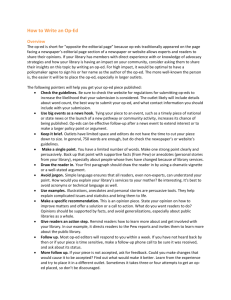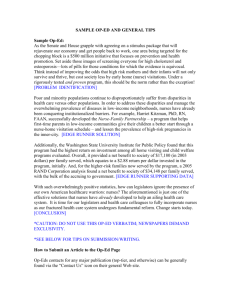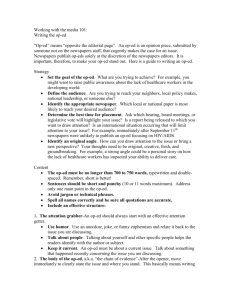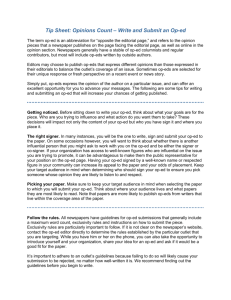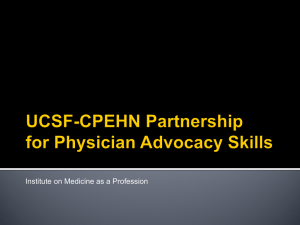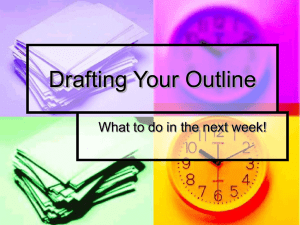op - ed /blog writing workshop
advertisement
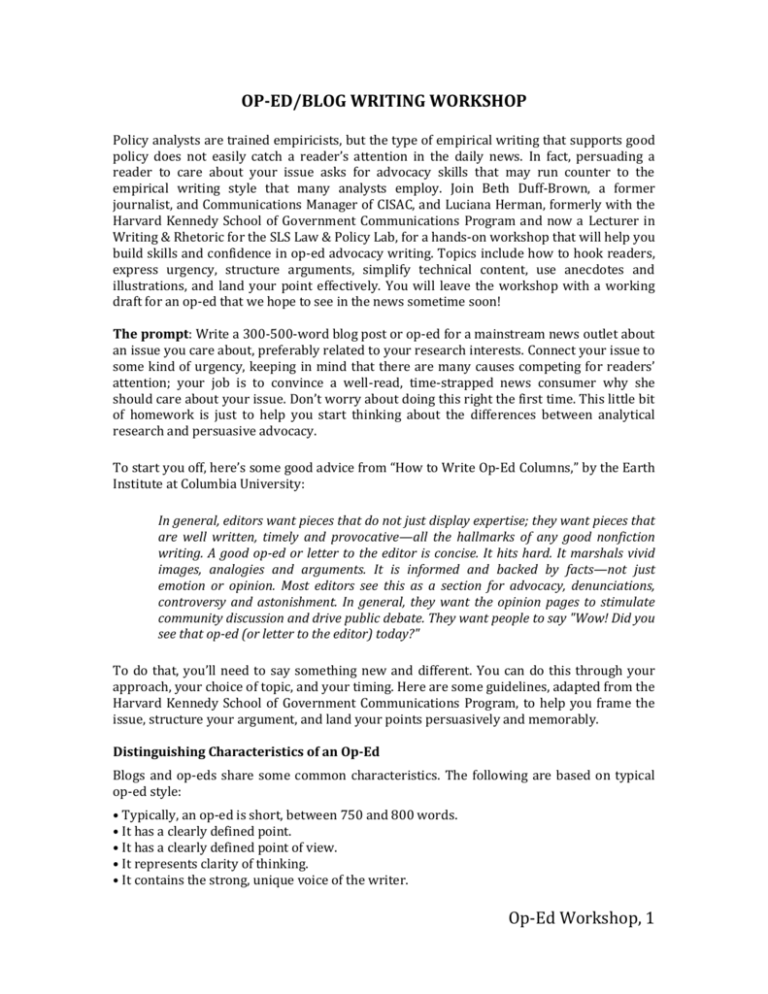
OP-ED/BLOG WRITING WORKSHOP Policy analysts are trained empiricists, but the type of empirical writing that supports good policy does not easily catch a reader’s attention in the daily news. In fact, persuading a reader to care about your issue asks for advocacy skills that may run counter to the empirical writing style that many analysts employ. Join Beth Duff-Brown, a former journalist, and Communications Manager of CISAC, and Luciana Herman, formerly with the Harvard Kennedy School of Government Communications Program and now a Lecturer in Writing & Rhetoric for the SLS Law & Policy Lab, for a hands-on workshop that will help you build skills and confidence in op-ed advocacy writing. Topics include how to hook readers, express urgency, structure arguments, simplify technical content, use anecdotes and illustrations, and land your point effectively. You will leave the workshop with a working draft for an op-ed that we hope to see in the news sometime soon! The prompt: Write a 300-500-word blog post or op-ed for a mainstream news outlet about an issue you care about, preferably related to your research interests. Connect your issue to some kind of urgency, keeping in mind that there are many causes competing for readers’ attention; your job is to convince a well-read, time-strapped news consumer why she should care about your issue. Don’t worry about doing this right the first time. This little bit of homework is just to help you start thinking about the differences between analytical research and persuasive advocacy. To start you off, here’s some good advice from “How to Write Op-Ed Columns,” by the Earth Institute at Columbia University: In general, editors want pieces that do not just display expertise; they want pieces that are well written, timely and provocative—all the hallmarks of any good nonfiction writing. A good op-ed or letter to the editor is concise. It hits hard. It marshals vivid images, analogies and arguments. It is informed and backed by facts—not just emotion or opinion. Most editors see this as a section for advocacy, denunciations, controversy and astonishment. In general, they want the opinion pages to stimulate community discussion and drive public debate. They want people to say "Wow! Did you see that op-ed (or letter to the editor) today?" To do that, you’ll need to say something new and different. You can do this through your approach, your choice of topic, and your timing. Here are some guidelines, adapted from the Harvard Kennedy School of Government Communications Program, to help you frame the issue, structure your argument, and land your points persuasively and memorably. Distinguishing Characteristics of an Op-Ed Blogs and op-eds share some common characteristics. The following are based on typical op-ed style: • Typically, an op-ed is short, between 750 and 800 words. • It has a clearly defined point. • It has a clearly defined point of view. • It represents clarity of thinking. • It contains the strong, unique voice of the writer. Op-Ed Workshop, 1 Questions to Ask Yourself When Writing an Op-Ed • Do I have a clear point to make? • What is it? • Am I the right person to write this article? What is my credibility? How can I highlight it? • Who cares? Who are trying to convince? Why are you targeting that specific reader? • Is the timing right? Is there some urgency to my argument? • Is there substance to my argument? Topic and Motive Every successful op-ed piece or column must have a clearly defined topic and theme. • Topic: the person, place, issue, incident, or thing that is the primary focus of the column. The topic is usually stated in the first paragraph. • Motive: another level of meaning to the topic. What is your motive in writing the piece? What’s the big, overarching idea of the op-ed? What’s your point? Why is your point important? The motive may appear early in the piece or it may appear later when it may also serve as a turning point into a deeper level of argument. Research While blog postings and op-ed pieces allow writers to include their own voice and express an opinion, to be successful they should be grounded in solid research. Research involves facts, quotations, citations, or data you’ve researched or gathered from sources and personal observation. Research also allows a reader to include sensory data (touch, taste, smell, sound, or sight) into an article. Give your reader the basic facts she needs to know about the issue/event at the heart of your commentary—and do it by the third paragraph at the latest. If your goal is to introduce an overlooked issue, then explain more. But in most posts, readers just need a couple of sentences of grounding - the background necessary to understand your argument, or to grasp where your story fits into the landscape of the larger issue. There are two basic methods of research: • Field research: going to the scene, interviews, legwork; primary materials, observations, and knowledge • Library, academic, or internet research: using secondary materials, or data you’ve collected and analyzed, including graphs, charts, scholarly articles, and statistics that support your points. Research and emotion: To keep it real, think of your research in terms of real people with real stories. How does your issue affect people? How could it affect your readers? Your readers want to know. Tell a story that makes the reader feel something- sadness, anger, inspiration- and she’ll be far more open to your overall argument. Even op-eds written for elite, scholarly audiences leverage emotion in persuading their readers or calling them to action. Remember, too, that sometimes the most compelling story is your own—i.e. why you personally care, or how you are directly or indirectly affected. Op-Ed Workshop, 2 Openings The first line of an op-ed is crucial. The opening “hook” may grab the reader’s attention with a strong claim, a surprising fact, a metaphor, a mystery, or a counterintuitive observation that entices the reader into reading more. Whenever possible, tie your piece to something that happened recently, is happening today, will happen soon. This can be an anniversary, an event, the release of a report, a controversial public statement, or breaking news. The opening also briefly lays the foundation for your argument. Endings Every good blog posting or op-ed piece should have a strong ending which has some basic requirements. The best endings—or “kickers,” as they’re called in journalism—leave the reader with something to think about or with an emotional response. In advocacy writing, this can also be a place to put your “ask.” The following are an array of methods to land your final point: • Echoes or answers the introduction, using the theme of the introduction as a kind of “frame” for the piece • Has been foreshadowed by preceding thematic statements • Is the last and often most memorable detail • Contains a final epiphany or calls the reader to action There are two basic types of endings. An “open ending” suggests, rather than states, a conclusion, while a “closed ending” states, rather than suggests, a conclusion. The closed ending in which the point of the piece is resolved is by far the most commonly used. Voice Having a strong voice is critical to a successful blog or op-ed piece. Blogs are most typically conversational in tone, so you can imagine yourself have a conversation with your reader as you write (a short, focused conversation). But the range of voice used in blogs can be wide: contemplative, conversational, descriptive, experienced, informative, informed, introspective, observant, plaintive, reportorial, self-effacing, sophisticated, humorous, among many other possibilities. Sometimes your choice of voice is driven by your target publication. Think carefully about the tone and voice of that publication, then, perfect your voice by reading your blog posting or op-ed out loud. This will give you a clearer sense of how your piece may come off to your intended reader. If you are especially daring, you can even record yourself reading the piece and then listen to it critically with a friend who will tell you what they really think. Revision Checklist Some things to remember as you revise your op-ed or blog posting before you submit it for publication or upload it to your website: Check clarity. Check coherence and unity. Check simplicity. Check voice and tone. (Most are conversational; some require an authoritative voice.) Is there a clear “ask”? Check for jargon. Is it jargon free? Check direct quotations and paraphrasing for accuracy. Op-Ed Workshop, 3 Check attribution of all sources, not in footnotes, but in hyper-linked language: “according to a recent study by CISAC fellow Herb Lin”. Check the consistency of your opinion throughout your op-ed or column. (You may be surprised that you changed your tone – or even your mind -- as you wrote the piece!) Resources The Op-Ed Project (http://www.theopedproject.org) is a terrific resource for anyone looking to strengthen their op-ed writing. It provides tips on op-ed writing, suggestions about basic op-ed structure, guidelines on how to pitch op-ed pieces to publications, and information about top outlets that publish op-eds. Started as an effort to increase the number of female op-ed writers, The Op-Ed Project regularly runs daylong seminars for women around the country. The Op-Ed Project suggests this structure: Lede (Around a news hook) Thesis (Statement of argument – either explicit or implied) Argument: Based on evidence (such as stats, news, reports from credible organizations, expert quotes, scholarship, history, first-hand experience) o 1st Point evidence evidence conclusion o 2nd Point evidence evidence conclusion o 3rd Point evidence evidence conclusion Note: In a more complex commentary, the 3rd point may expand on the bigger picture—historical context, global/geographic picture, mythological underpinnings, etc.—or may offer an explanation for a mystery that underpins the argument– eg., why a bad policy continues, in spite of its failures. “To Be Sure” paragraph (in which you pre-empt your potential critics by acknowledging any flaws in your argument, and address any obvious counterarguments.) Conclusion (often circling back to your lede) Examples Some examples of op-eds to get you started on thinking about how you will frame your own. You’ll recognize some of your favorite CISAC faculty and fellows here, among others: - Catch the wave of today’s news. This blog does it nearly daily. Write about your personal connection to the issue. Examples of a direct connection here and an indirect connection here. Op-Ed Workshop, 4 - - Explore the issue through the lens of one person/community. In other words, tell the reader a story, and provide plenty of detail to make that story come alive. Example here (this post is written by a journalist, but the first several paragraphs are a very good model for this approach). Another example here. Offer up a perspective, or an angle, that’s unexpected or bucks the prevailing trend in the discussion. Example here. Advocate for actionable change, leveraging your own credibility to target a policy audience that you know personally. Example here. Tell me something I don’t already know/highlight an overlooked issue within the larger debate. Example here Quick, scannable research, based on your own findings, with a turning point motive mid-way through. Example here. A deep dive into the history to shed new light on a current problem. Example here. Note: Some of these are more persuasive than others. Your critical eye will surely lead to observations that you can improve in your own work. If we have time in the workshop, we’ll discuss what works well and what doesn’t in these posts. Op-Ed Workshop, 5
